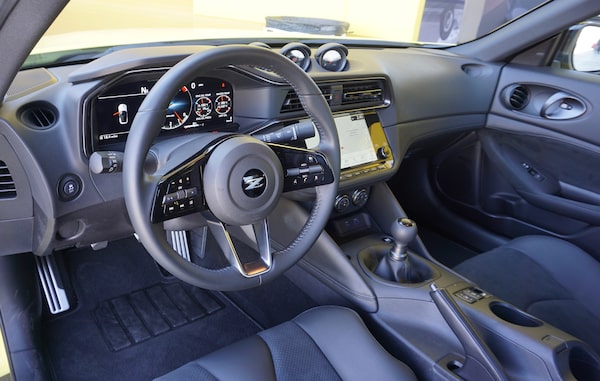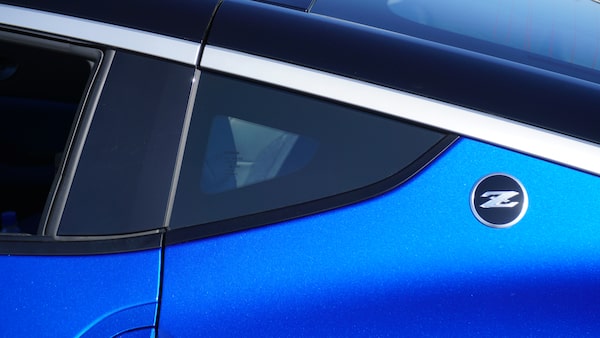
The 2023 Nissan Z. This is the seventh generation of Z cars since the original 1970 240Z.Jeremy Sinek/The Globe and Mail
The irony is hard to ignore. Our designated drive route in the new Nissan Z takes us from Las Vegas, Nev. to Lake Mead, the huge reservoir behind the Hoover Dam that supplies water to America’s arid Southwest.
Clearly visible are the historically low water levels, the product of drought that seems inseparable from the ravages of climate change. And here I am, driving Nissan’s new 400-horsepower, unapologetically gasoline-powered sports car that starts at less than $50,000.
Still, perhaps we can cut Nissan some slack. This is, after all, the company that re-birthed the electric car with the 2011 Leaf. Nissan is also on track for 50 per cent of its worldwide sales to be electric by 2030.
And let’s face it: Detroit builds more fuel-thirsty big pickup trucks in a single year than Nissan has built Z cars over the entire 53 years since the original 1970 240Z.
Six previous generations of the Z sometimes strayed from the honest, every-person’s sports-car concept of the original, morphing into a bloated boulevardier in the 1980s, a Porsche-baiting junior exotic in the ‘90s, and MIA altogether in the late ‘90s and early 2000s. The nameplate returned to its roots with the 2003 350Z, evolved into the 2009 370Z, and now is substantially updated again – though still on the same architecture for 2023.
Beneath the evolutionary styling revisions, a new 400-horsepower twin-turbo three-litre V6 engine, familiar from Infiniti, replaces the previous 332-horsepower, 3.7-litre naturally aspirated V6. Maximum torque swells to a 350 lb-ft plateau between 1,600 and 5,600 revolutions per minute, from a 270 lb-ft peak at 5,200.
The standard six-speed manual gearbox has been tweaked for easier shifting and the optional automatic gains two ratios for a total of nine. Launch control is available, plus the manual allows no-lift upshifts and rev-matches downshifts.
As well, the body is stiffer, electric steering assist replaces the previous hydraulics and the brakes and suspension have been fine-tuned for enhanced feel and linearity. The standard 18-inch and higher-trim 19-inch wheel sets now wear wider front tires that, Nissan claims, increase cornering power by 13 per cent.
Whether or not you care about ultimate performance, all buyers should appreciate a renewed interior that adds telescopic steering-column adjustment, a thicker-rimmed wheel, a second cupholder, more-supportive seats and a standard 12.3-inch configurable digital gauge cluster. Nissan has also added enough assisted-drive features to enhance safety without detracting from an engaged driving experience.
In Canada the Z launches this July in Sport and Performance grades, plus a limited-edition Proto Spec model with yellow brake calipers, bronze wheels and different interior accents.
Starting at $46,498 – about $22,000 less than a Toyota Supra, $24,000 below a base Porsche Cayman – the 400-horsepower Z is a bargain among two-seat performance cars. As for the climate-change guilt trip, consider this: for less than the price of some comparably powerful sports-car alternatives, you could, if you live in the right province, buy yourself a Nissan Z for sunny weekends plus a Nissan Leaf as your zero-carbon daily driver.
Tech specs

The Nissan Z is substantially updated for 2023.Jeremy Sinek/The Globe and Mail
2023 Nissan Z
- Price: $46,498 – $65,748
- Engine: three-litre twin-turbo V6
- Transmission/drive: six-speed manual or nine-speed automatic/rear-wheel drive
- Fuel consumption (litres per 100 kilometres): Manual: 13.4 city/10.0 highway; Automatic: 12.3 city/8.6 highway
- Alternatives: Audi TT, BMW Z4, Chevrolet Corvette, Mazda MX-5, Porsche Boxster, Toyota Supra
Looks

Taillights on the 2023 Nissan Z echo the 300ZX.Jeremy Sinek/The Globe and Mail
If you liked it before, you won’t like the new one any less. Aside from subtle sheet-metal re-sculpting, key recognition points include flush door handles, daytime running lights that channel the lights on the 1970s original and taillights that echo the 300ZX.
Interior

The interior of the 2023 Nissan Z.Jeremy Sinek/The Globe and Mail
It’s a strict two-seater, but the addition of telescopic steering, along with eight-way seat adjustment, should enable a comfortable posture for more drivers, appropriately low-slung but without unduly compromising visibility. The centre touch screen is small by today’s standards, leaving physical controls for basic audio and all climate control functions (though the latter are too low to see easily).

The instrument cluster on the 2023 Nissan Z.Jeremy Sinek/The Globe and Mail
Three analogue gauges atop the centre dash, and up to six virtual dials in the configurable digital gauge cluster, can provide more information (such as turbocharger revolutions per minute) than most drivers will know what to do with.
Performance
An available six-speed manual and 400 horsepower through the rear-wheels makes a seductive combo for skilled, engaged enthusiasts. The new electric power steering weights up nicely at speed and relays good feel when carving a turn, but could be sharper on centre. But even this die-hard stick-shifter prefers the Z as an automatic. The manual shift quality and the clutch are user-friendly, but not quite an outright tactile delight. With launch control, more ratios and automated shifting, max acceleration should be both quicker in the automatic and easier to achieve – about 4.5 seconds to 100 kilometres an hour, we reckon. And while the engine is smooth, delectably tuneful and loves to rev, the automatic remains smooth all the way to 7,000 revolutions per minute, while the manual cars can get rough above 6,000.
Technology
Apart from automatic emergency braking, driver-assist technology is limited to “watch-and-warn” features – forward-collision, blind spot, lane departure, and rear cross-traffic – without active interventions. Standard infotainment features include Bluetooth, CarPlay and Android Auto, SiriusXM and hands-free texting; the Performance adds navigation, a Wi-Fi hot spot and NissanConnect services.
Cargo

The trunk on the 2023 Nissan Z.Jeremy Sinek/The Globe and Mail
Accessed by a lifting tailgate, the shallow, irregular trunk has a volume of 6.9 cubic feet.
The verdict

Jeremy Sinek/The Globe and Mail
As modern cars become increasingly robotic and soulless, the 2023 Z is a welcome holdout, a “real” car with a cracking new engine and a finessed chassis that’ll satisfy “real” drivers, yet still livable for those who only want to look the part.
The writer was a guest of the automaker. Content was not subject to approval.
Shopping for a new car? Check out the new Globe Drive Build and Price Tool to see the latest discounts, rebates and rates on new cars, trucks and SUVs. Click here to get your price.